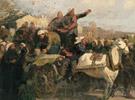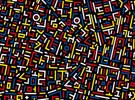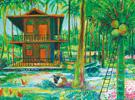Defaced Icons and Assembled Utopia: Jiang Hai’s Case of Art and Politics
By Zhijian Qian
《乾坤》 江海作品
Visually unflattering and conceptually disturbing, Jiang Hai’s Assembled Utopia makes a strong case that illustrates the perplexing relationship between art and politics in today’s China. A set of paintings with wittily appropriated images of the most popular and standard portraits of great communist teachers and leaders from Karl Marx to Mao Zedong, it is an unworshipful re-presentation of the extremely iconic communist characters with a critical review of the ideological history, institutions, systems and outcomes they stand for. The author Jiang Hai is a veteran of the post-Mao generation artists who was an active party in the trend of turning art from a tool for serving politics into a means of critiquing politics. Unlike many other artists who tend to ride the tide from one to the other, as did some of the Political Pop and Cynical Realism groups, Jiang Hai persisted in his pursuit of art as a critiquing tool of social, political and cultural realities from the mid-1980s to the present. To understand Jiang Hai’s Assembled Utopia in the historical context of a China that has undertaken the most drastic and dramatic changes in its modern history provides us a unique perspective to comprehend the relationship between art and politics in China, a significant theme Chinese art of the 20th and 21st century.
Assembled Utopia (2010-2011) is an oil-on-canvas work composed of forty-five square pieces that, according to the artist himself, can be arranged in at least four different ways for display. In three of the four ways, the forty-five pieces, each measures 100 by 100 centimeters, are arranged in five groups, or separate assemblages. Each group is composed of nine pieces that are arranged in a three by three fashion, giving the piece a large square format. In the first of the three square-format arrangements, which Jiang Hai names The Original Utopia, each of the five large squares has a contour of the face of a highly iconic character that is easily identifiable to anyone who is not unfamiliar with the communist history of China. Although their faces are covered with deformed and distorted bodies, they could easily identify as Karl Marx, Friedrich Engels, Vladimir Lenin, Joseph Stalin and Mao Zedong. In the second of the three square-format arrangements, which the artist names The Transformed Utopia, each of the five iconic faces has parts taken from other four faces, although they still have their own identifiable features. For instance, in The Transformed Utopia: Mao Zedong, the upper right panel is taken from the assembled image of Friedrich Engels; the lower middle panel that forms his chin is borrowed from the assemblage of Karl Marx; the left middle panel from Joseph Stalin, and the center piece from Vladimir Lenin. In the third way of assemblage and display, which the artist names The Deformed Utopia, each of the five faces is presented with the same nine panels as in The Original Utopia, but they are rearranged in a so completely different way that none of the faces is instantly identifiable. Although all the pictorial elements of each portrait remain unchanged, they do not form in any consistent way a portrait or even a contour or outline of a portrait. In The Deformed Utopia: Karl Marx, for example, the upper center panel that forms Marx’s forehead in The Original Utopia is now the lower right panel that is placed sideways, and most of the panels are either switched in position or placed differently. The most dramatic change is seen in the artist’s rearrangement and re-assemblage of all the forty-five panels in one gigantic piece of five by nine panels, under the collective title Utopia on the Other Shore, in which no specific face or portrait could be identified as they now have become parts of a haunting landscape with a huge mound at the center built up of numerous dismembered bodies against a bloodily red background with patches of light blue that may be seen as clouds or water. It looks like that the artist could create as many different assemblages or combinations as he wishes after he scrambles and reshuffles the panels like playing cards.
But the artist has his reason for choosing the four particular ways for displaying his work. Although the first three different ways of display make the panels look like preparatory for Utopia on the Other Shore, they should be seen as independent sets that have their own meanings before they are dismantled and reorganized into a completely new composition. As their titles suggest, the three sets indicate the three phases of the eventually dismantling process of a communist utopia. In the Original Utopia, according to the artist, each of the five faces is occupied with dismembered human bodies that are arranged and designed in symbolic structures. In the Original Utopia: Karl Marx, for example, the bodies that are clustered around a central point near Marx’s nose also form radiating lines that have connotations of original point, spread, greatness and communism, etc. When the five sets are taken into account as a whole, the implied symbols are connected into a significant narrative that has a critical review of the formation and development of the ideas and ideals of a communist utopia from Marx to Mao. This narrative is unfolded in its enigmatic fabrications of dismembered bodies that are reminiscent of violent revolutionaries, tragedies and massacres in the history of the great communist cause over the whole 20th century, from the October Revolution to the Reform of Socialism with Chinese Characteristics. Thus, Engels’ face is covered with bodies that are formed in the shape of a net that stands for perfection and continuation, Lenin’s face with bodies in form of the letter V for victory, Stalin’s with a cross for death and crucifixion, and Mao’s with piles of overlapped bodies reminiscent of the lives taken during a series of political campaigns. The dismantling process is one from order to chaos and hope to despair, although the original point implied in the center of Karl Marx is stable and positively radiating.
The enigmatic messages of violence and tragedy are emphasized by Jiang Hai through his unique visual effects composed of conflicting styles. One might be tempted to label his painting as expressionist, abstract or abstract expressionist, but a close examination of the details in each of the five assembled works reveals that there is much richer sources of inspiration for Jiang Hai’s art. In the Original Utopia: Stalin, for example, images of butchered bodies may immediately allude to paintings of Francis Bacon and Graham Sutherland, who are known for their bold, threatening and emotionally raw imagery of human bodies and other organic forms. But whereas Bacon and Sutherland focus more on the grotesqueness of dramatically distorted individuals, Jiang Hai presents the bodies as organic parts of a larger collective. Both Bacon and Sutherland aim at visualizing the suffering souls from inside individual bodies, while Jiang Hai tends to minimize the individuality of the bodies that are but sacrificed subjects for the sake of the great cause of communist utopia. The bodies in the paintings of Bacon and Sutherland are live, vibrant and violent, but those in Jiang’s – whether they are headless or not – are neither live nor dead but rather in a state in between where they are held in endless torture and suffering. On the level of visual effects, both Bacon and Sutherland use explosive forms and brushwork to create a strong sense of unrestraint and loss of control, while Jiang Hai arranges the bodies in a controlling way into his desired forms, shapes and designs. His early influence from Willem de Kooning, which is obvious in his works from the 1990s such as the Unbelievable series, is integrated in the Assembled Utopia into unique abstract visual effect enabled by his absorbance of the traditional technique of ink wash in Chinese painting. This is clearly shown in the disturbing red background behind each of the five iconic heads, which is marked by the smooth fluidity of abstract forms applied in thin acrylic onto the canvas. The contrast between the relatively flat background and the intertwined bodies with rich textures made by thick oil paints well demonstrates the artist’s capability in successfully maneuvering formal elements and colors and his strong interest in achieving painterliness. Furthermore, the strong contrast between the clearly outlined icons in contours and the freely and expressively formed bodies is an indication of the artist’s self-conscious abandonment of the Socialist-Realist tradition that generations of modern Chinese artists have been educated with. Although influences from other Western artists such as those of Neo-Expressionism could also be tracked down in Jiang Hai’s paintings, especially his earlier ones, his art after all is not a simple response to the changes of art movements in the West, but rather an expression of the artist himself as an individual who has gone through many of the social, political and economical changes and reforms in China over the past three decades.
These icon-based works of Assembled Utopia are meant to be dismantled from the very moment they are created. The four different combinations represent the four phases of creation, transformation, deformation, loss and failure of a great communist utopia along with its faith and ideology in the world in general and in China in particular. The first three combinations are preludes to the fourth one of great chaos, where all orders, if any, are destroyed by the rearranging of the panels. They are also footnotes to the final product, which acknowledges the sources and reasons of the chaotic situation in the final combination. The four combinations are therefore sequential, one after the other, working together as parts of the same storyboard for the very creation of a total and complete Assembled Utopia. Although at an actual exhibition of the work only one combination could be viewed at a time, all the four specially designed different combinations should be taken into consideration when one tries to fully understand the work with all its implied messages.
The identifiable icons in the portraits in contours are double defaced once they are taken apart like dismembered bodies. If in The Original Utopia overlapping the icons with elongated bony bodies indicates the first intention to deface the icons, then in the following sequences the icons are further defaced each and every time they are rearranged and re-assembled until they are dissolved into nearly unrecognizable fragments. The artist’s very act of dismantling the assemblages and recomposing them into new ones, along with the products his act results in, is itself part of his critical review of the history of the communist utopia. Assembled Utopia is not, however, just about the political icons. To some extent, it is more about the victims of a failed utopia, who exist in Jiang Hai’s pictorial world as suspended bodies whose cultural, social, political and ethnic identities are neither known nor significant. As the result of multiplied dismantlement, The Utopia on the Other Shore is thus a projected view of the spectacularly chaotic vista of the current utopia with its social and political conditions far so different from what was predicted from the original point.
Yet Jiang Hai’s defacing the icons is by no means an absolute negation of the communist utopia with its ideology. Unlike the Political Pop and Cynical Realist artists who tend to adopt a playful, negative and even insulting attitude towards political icons in their imagery of defaced characters, Jiang Hai has an uncompromisingly seriousness in his critical questioning of the ideas and ideals that the communist utopia stands for and the results it brings to this present time. His critique is one of doubt, investigation and challenge as well as sympathy, compassion, lamentation and even nostalgia. His visual critique of the loss of faith in a China that is going in a direction no one is certain about is made with hope, expectation, and even implicit optimism as lamenting over the past and the present is a positive and optimistic attitude toward a promising future. Therefore, Assembled Utopia is not simply about the disillusion of faith, but more about rethinking of the “original point”, which once promised great expectations in human history. However, in a time when publicly defacing political icons is still some sort of a taboo on certain level, Jiang Hai’s work is a visual metaphor that depicts what is unsayable. It is not only a personal visual commentary, but also a visual reminder to us to look at our past and present from a normally unthinkable perspective. Most importantly, Assembled Utopia is a work that provides us with a great case for our study of the relationship between art and politics in a China that is playing an ever increasingly significant role in the world political affairs in the era of globalization.
March, 2011
In Kew Gardens, New York





